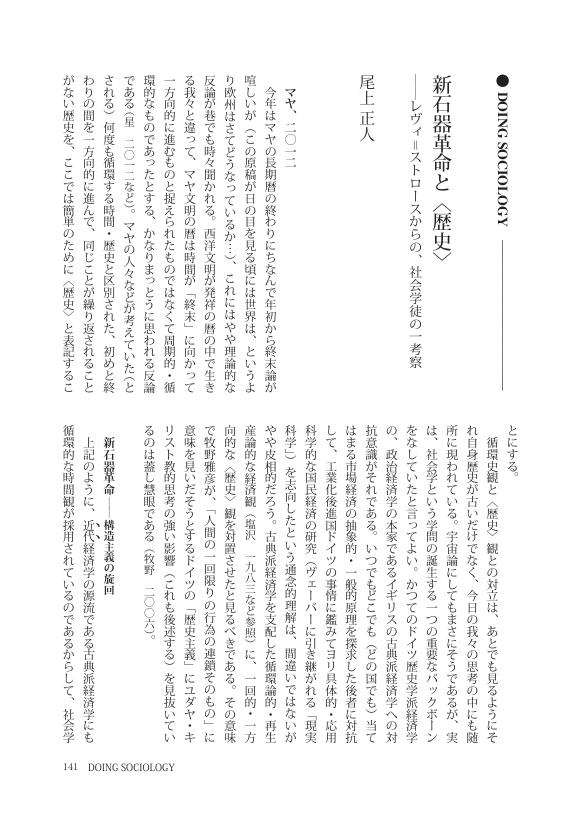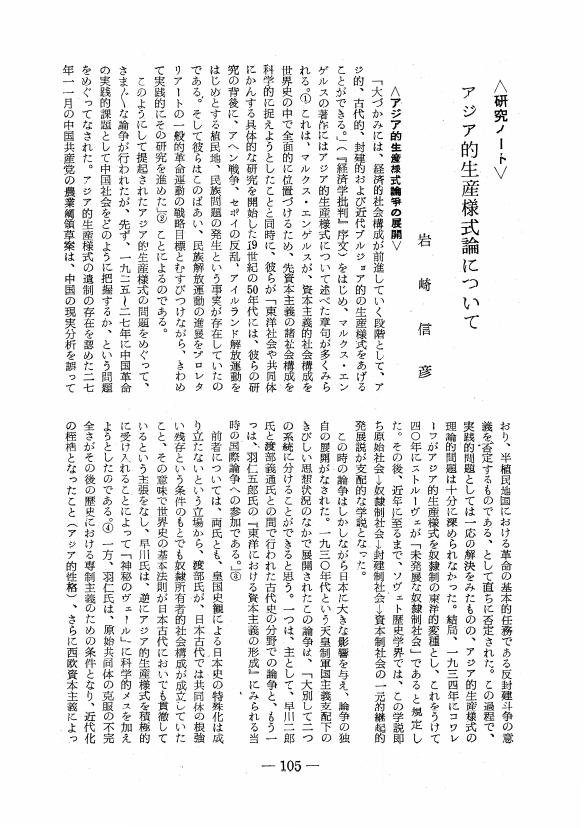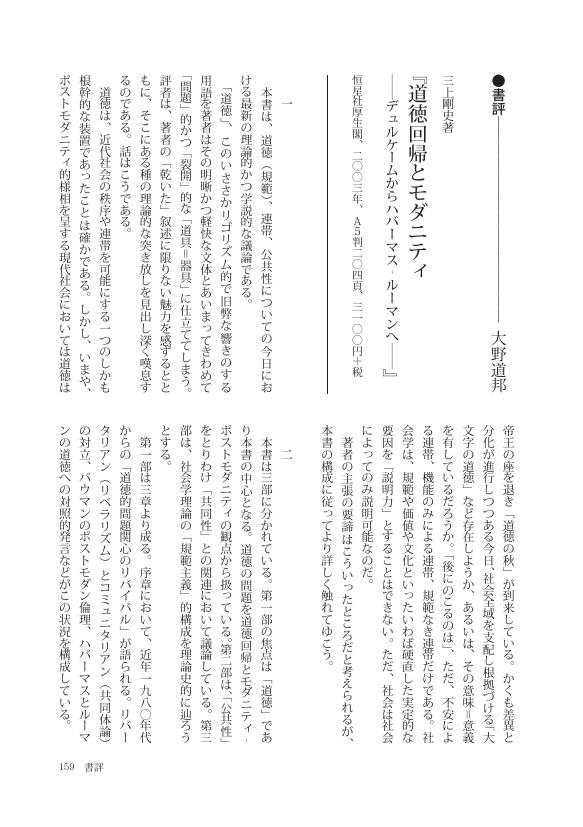1 0 0 0 無責任の体系とそのいけにえ
- 著者
- 奥村 隆
- 出版者
- 社会学研究会
- 雑誌
- ソシオロジ (ISSN:05841380)
- 巻号頁・発行日
- vol.63, no.2, pp.127-129, 2018-10
- 著者
- 赤川 学
- 出版者
- 社会学研究会
- 雑誌
- ソシオロジ (ISSN:05841380)
- 巻号頁・発行日
- vol.63, no.3, pp.123-131, 2019-02
- 著者
- 姚 逸葦
- 出版者
- 社会学研究会
- 雑誌
- ソシオロジ (ISSN:05841380)
- 巻号頁・発行日
- vol.63, no.3, pp.59-77, 2019-02
1 0 0 0 二人のコーエン
- 著者
- 難波 功士
- 出版者
- 社会学研究会
- 雑誌
- ソシオロジ (ISSN:05841380)
- 巻号頁・発行日
- vol.64, no.1, pp.128-130, 2019-06
1 0 0 0 居場所概念の再検討 : 子ども食堂における参与観察をとおして
- 著者
- 尾添 侑太
- 出版者
- 社会学研究会
- 雑誌
- ソシオロジ (ISSN:05841380)
- 巻号頁・発行日
- vol.64, no.2, pp.39-56, 2019-10
1 0 0 0 OA 新石器革命と〈歴史〉
- 著者
- 尾上 正人
- 出版者
- 社会学研究会
- 雑誌
- ソシオロジ (ISSN:05841380)
- 巻号頁・発行日
- vol.57, no.1, pp.141-146, 2012-06-30 (Released:2015-05-13)
- 参考文献数
- 17
- 著者
- 佐野 和子
- 出版者
- 社会学研究会
- 雑誌
- ソシオロジ (ISSN:05841380)
- 巻号頁・発行日
- vol.64, no.1, pp.21-40, 2019-06
- 著者
- 水野 英莉
- 出版者
- 社会学研究会
- 雑誌
- ソシオロジ (ISSN:05841380)
- 巻号頁・発行日
- vol.50, no.2, pp.121-138, 2005
1 0 0 0 OA 曖昧な喪失における情報提供とケアの実践 MPSの取り組みを事例として
- 著者
- 中森 弘樹
- 出版者
- 社会学研究会
- 雑誌
- ソシオロジ (ISSN:05841380)
- 巻号頁・発行日
- vol.59, no.1, pp.75-90, 2014-06-30 (Released:2019-05-24)
- 参考文献数
- 12
- 著者
- 牧野 智和
- 出版者
- 社会学研究会
- 雑誌
- ソシオロジ (ISSN:05841380)
- 巻号頁・発行日
- vol.54, no.2, pp.107-122, 2009
- 著者
- 片田 孫 朝日
- 出版者
- 社会学研究会
- 雑誌
- ソシオロジ (ISSN:05841380)
- 巻号頁・発行日
- vol.48, no.2, pp.23-38,157, 2003
This article explores the masculine practice of elementary schoolboys and it's embodiment in their play activity and conversation.<br> In Japan, most scholars of Men's Studies have adopted the Social Learning Theory of sex role, which argues that children learn appropriate behavior and attitudes through various sanctions from their parents and others, and through watching television and reading books. Internalization of masculine norms and values, such as "boys must not cry", has often been assumed in these studies. Generally, gender studies, including Women's Studies in Japan have accepted this kind of socialization theory.<br> In contrast with these arguments, this study places great importance on child-peer interaction and tries to understand young boys' masculine speech and behavior as useful "social skills" in their interaction.<br> The data is based on participant observation of boys and girls aged six to nine in a child care center in Kyoto city over six months in 2002. It was found that children mostly play segregated into groups of boys and girls. With reference to anthropologist Majorie Goodwin's work, an investigation of how boys and girls design directive and response was conducted. The results are as follows.<br> Boys often make their directives emphasizing hierarchical arrangements among members. Imperative forms such as "yamero(stop)" and aggressive terms are used to construct asymmetry participant structure. It can be observed that leaders frequently instruct other team-mates in aggravated forms, denouncing their skills in the team games that young boys like to play. These practices are conducted with self justification in order to win the game. In these cases, thoughtfulness is not expressed between playmates, and boys of lower status also try to assert themselves as strongly as possible. Therefore, masculine behavior is practiced and learned not only because of social norms, but also because of its usefulness in social activity and interaction.<br> This study shows the process whereby masculine plactice is constructed as social skills and emphasizes the importance of ethnography of social activity and practice for gender studies.
1 0 0 0 OA 大正期における近代的結婚観の受容層
- 著者
- 桑原 桃音
- 出版者
- 社会学研究会
- 雑誌
- ソシオロジ (ISSN:05841380)
- 巻号頁・発行日
- vol.58, no.1, pp.71-88,182, 2013-06-30 (Released:2015-05-13)
- 参考文献数
- 30
Sociological studies of modern families in Japan focus on new middle-class women as a group who held modern views of marriage in the Taisho Period, but do not provide substantial analysis. This paper examines who accepted the concepts of modern marriage in this period by quantitatively analyzing the correlation of the attributes of contributors to the “personal-advice column” in the Yomiuri Shimbun. Careful scrutiny of the aforementioned sociological studies points the twocrucial elements in the concept of modern marriage: free will in choosing his/herspouse and emotional ties between them. With these two elements as criteria, thecontributions which revealed the concepts of modern marriage were selected. Then, by reading the selected contributions intensively with regards tothe four categories of gender, residential area, educational background, andoccupations of the contributor, they were quantitatively analyzed. On the basisof the analysis, this paper brought forward the following findings about theacceptance of the concepts of modern marriage: 1. no correlation with residentialareas and educational background, 2. tendency of men > women, 3. high ratio ofstudents, white collar workers, and independent entrepreneurs, 4. high ratio ofstudents among men and of white collars among women. The examination of thecontributions concerning free will and emotional ties indicate that people witha high level of education, and students revealed a strong tendency to emphasize‘emotional ties’ and ‘emotional ties as well as free will’. With these, it could be maintained, concerning the acceptance of the concepts of modern marriage, firstly that the findings do not necessarily support the view that mainly focuses upon the new middle class women, and secondly, that the school culture played an important role.
1 0 0 0 OA 童心の時代
- 著者
- 河原 和枝
- 出版者
- 社会学研究会
- 雑誌
- ソシオロジ (ISSN:05841380)
- 巻号頁・発行日
- vol.36, no.3, pp.53-70,145, 1992-02-29 (Released:2017-02-15)
Modern children's literature was established in Japan during the Taisho era, when the magazine Akai Tori was the center of a movement to develop stories (dowa) and poetry (doyo) especially for children. Authors and poets of the day praised the purity and innocence of children, and strove to create works of children's literature that reflect that "childlike mind" (doshin). For that reason, children's literature from this period is known as "doshinshugi" literature, the literature of "childlike innocence." The idealization of childlike innocence was not restricted, however, to the field of children's literature. Examination of the manifestations of this preoccupation in a wider socio-cultural context reveals the following points: 1. The literature of "innocence" was greatly influenced by the image of children in modern western literature, romanticism in particular. However, the concept of the pure and innocent mind of the child was not merely a western import. As can be seen from the writings of Kitahara Hakushu, the founder of children's poetry, it also includes supposedly traditional Japanese images of children. Here we may see a case of what Eric Hobsbawm has called the "invention of tradition." 2. The rhetoric of childlike innocence, while praising the concept of motherhood, at the same time is accompanied by an attitude which ignores motherhood. Doshinshugi thus reflects the male-dominated culture. 3. Childlike innocence was associated with the popular image of the Edo-period priest Ryokan, propagated during the Taisho era by Souma Gyofu. This gave birth to the legend of Ryokan having a childlike heart. This is another example of the invention of tradition. The Ryokan legend played an important role in spreading the idea of childhood innocence throughout the populace. 4. The idea of childlike innocence had for the artists of the day an image of selfliberation, and served to mediate the conflict between their western frame of reference, derived from literature, and the real society of Taisho Japan in which they lived. For that reason doshin became a key word of the times.
1 0 0 0 OA アジア的生産様式論について
- 著者
- 岩崎 信彦
- 出版者
- 社会学研究会
- 雑誌
- ソシオロジ (ISSN:05841380)
- 巻号頁・発行日
- vol.15, no.1, pp.105-113, 1969-07-31 (Released:2017-12-28)
1 0 0 0 OA 国家の「相対的自律性」再考
- 著者
- 山田 信行
- 出版者
- 社会学研究会
- 雑誌
- ソシオロジ (ISSN:05841380)
- 巻号頁・発行日
- vol.41, no.3, pp.55-74,105, 1997-02-28 (Released:2016-12-22)
This paper attempts to rethink the "relative autonomy" of the state in capitalist society and criticize "state-centered approach" theoretically. First of all the debate on this concept in neo-Marxism in 1970' s is reviewed and the fact that this concept has a very delicate implication of the autonomy is confirmed. Secondly three phases, in which the autonomy of the state emerges, is theoretically formalized and this frame of reference is applied to the analysis of three typical developmental states which are those in Japan, Korea and Taiwan. Thirdly it is assured that the specificity of developmental states can be grasped by that frame. But this does not signify that the developmental state has the "relative autonomy" and it is suggested that it should be not normal capitalist states, which are formed by contingent factors.
1 0 0 0 OA 戦後日本の受勲者における職業間格差
- 著者
- 小川 賢治
- 出版者
- 社会学研究会
- 雑誌
- ソシオロジ (ISSN:05841380)
- 巻号頁・発行日
- vol.30, no.3, pp.97-116, 1986-01-31 (Released:2017-02-15)
1 0 0 0 OA 石川准著 『アイデンティティ・ゲーム--存在証明の社会学』
- 著者
- 土井 隆義 石川 准
- 出版者
- 社会学研究会
- 雑誌
- ソシオロジ (ISSN:05841380)
- 巻号頁・発行日
- vol.38, no.1, pp.88-95, 1993-05-31 (Released:2017-02-15)
1 0 0 0 OA 三上剛史著 『道徳回帰とモダニティ--デュルケームからハバーマス・ルーマンへ』
- 著者
- 大野 道邦 三上 剛史
- 出版者
- 社会学研究会
- 雑誌
- ソシオロジ (ISSN:05841380)
- 巻号頁・発行日
- vol.49, no.1, pp.159-166, 2004-05-31 (Released:2016-05-25)
1 0 0 0 OA 〈公共哲学としての社会学〉へのいくつかの途
- 著者
- 中島 道男
- 出版者
- 社会学研究会
- 雑誌
- ソシオロジ (ISSN:05841380)
- 巻号頁・発行日
- vol.48, no.1, pp.136-138, 2003-05-31 (Released:2016-05-25)
1 0 0 0 OA 批判としてのモデルネ論
- 著者
- 吉田 純
- 出版者
- 社会学研究会
- 雑誌
- ソシオロジ (ISSN:05841380)
- 巻号頁・発行日
- vol.33, no.3, pp.21-37,157, 1989-01-31 (Released:2017-02-15)
Dieser Aufsatz zielt darauf, in Adomos Theorie der ästhetischen Modeme einige bedeutenden kritischen Momente, die Habermas verlassen hat, wiederzuentdecken, und damit die Schwächen der von Habermas dargestellten Theorie der Modeme nachzuweisen. Die frühe kritische Theorie von “Frankfurter Schule”, vertreten von Adorno, hat im “vernünftigen Potential” der modernen Kultur, insb. im "transzendierenden" Moment der Kunst, den privilegierten Bezugspunkt für die Kritik findet. Habermas sagt folgendermaßen : Adorno verliert gerade an dieser Strategie die "normative Grundlage" der Kritik, denn er die kulturelle Modeme mit “eingeengten Optik” wahrnimmt, und also sich nicht auf empirischer Analyse von Gesellschaft beziehen kann. Auf diesem Grund behauptet er die Theorie der Moderne, die die allgemeine kulturelle Moderne -- Wissernschaft, Moral und Kunst-- als drei differenzierte Aspekte der “kommnikativen Rationalität” erfassen und analysierbar machen will. Aber in dieser Theorie der Moderne ist der kritische Moment in der modernen Kunst, der "ästhetishen Rationalität", vielmehr unklar. Denn in dieser Theorie wird die “Kritik” auf die sprachliche Kritisierbarkeit der Geltungsansprüche jeweiliger Aussage reduziert. Für Adorno darbietet die musikalische Avantgarde, bzw. atonale Musik von Shönberg, ein Modell des kritischen Denkens. Sie sprengt die Grenzen der Tanalität, die der traditionellen Musik einen Schein intersubjektiver Sprache gegeben hat, indem sie sich auf ihre Material selbst, bzw. Tonsystem, reflexsiv bezieht und ihn zum Thema der Darstellung macht. Das andeutet die Möglichkeit des nichtidentifizierenden, in diesem Sinne kritischen Denkens. Eine die Allgemeinheit in Anspruch nehmende Theorie, wie die von Habermas, unvermeintlich sucht ihre Grundlegung in der Identität, bei ihm der intersubjektive. Aber solche Identität ist immer und bereits ein geschichtliches Erzeugnis. Muß die kritische Theorie, wie Habermas sagt, die geschichtliche Konstitution ihres Gegenstandes in Betracht ziehen, so kann sie nicht mehr auf solche Identität vertrauen.






